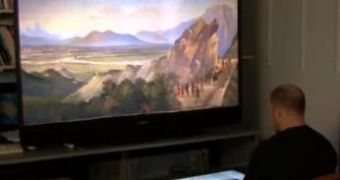Microsoft Surface is the perfect home for the digitized version of a 19th-century relic known as the Garibaldi Panorama. The Redmond company’s tabletop computer will be used to bring the 140-year-old print to the public, marking the culmination of a consistent digitizing effort that was announced initially back in 2007. The Garibaldi Panorama on Microsoft Surface will be the centerpiece of an exhibition focused on the evolution of digital scholarship, which will kick off this fall at the British Library.
“The Garibaldi Project by Brown University with support from Microsoft Research’s External Research and the British Library, offers access to the panorama on Microsoft Surface with images, documents, web pages, video and audio narration. You can even use a pen to make notations. With a large vertical screen on the wall, you can also share both the panorama and other resources with others. This was a joint project at Brown with the Department of Italian Studies and the Library’s Center for Digital Initiatives where most of the effort started late last summer,” Eric Havir, Sr. manager, Digital Communications at Microsoft/Surface, revealed.
In the video embedded at the bottom of this article, users will get a chance to witness the efforts that went into bringing the Garibaldi Panorama to Microsoft Surface. The 19th-century relic is no less than 273 feet long, five feet tall and printed on both sides. Visitors to the British Library exhibition in the fall of 2010 will have a chance to interact with the digitized Garibaldi Panorama, with the software giant’s tabletop computer offering a plethora of NUI features. Havir provided highlights of the interaction model designed to allow an entirely new user experience when it came down to interacting with the Garibaldi Panorama.
“- There are two screens for work and display running off Surface. The Surface screen contains navigation and additional information. The vertical screen removes the clutter, and is synchronized with the scrolling of the Surface screen used for sharing.
“- Hovering a hand over an information hot spot in the image opens a menu that lets you access additional related documents, videos, etc.
“- Flicking a document to the top of the Surface display will make it visible on the vertical display. All movement and resizing of the doc is matched on the vertical display. Multiple documents, videos, etc. can be interacted with in this fashion. Flicking them to the bottom of the Surface display removes them from the vertical display.
“- Web browser for external content with gesture support.
“- Magnification lens via object interaction. Lens movement and sizing is duplicated onto large vertical display.
“- IR-Light pen for notation and pen based gestures for moving and erasing notes.”
The Garibaldi Project from Ian Spector on Vimeo.

 14 DAY TRIAL //
14 DAY TRIAL //